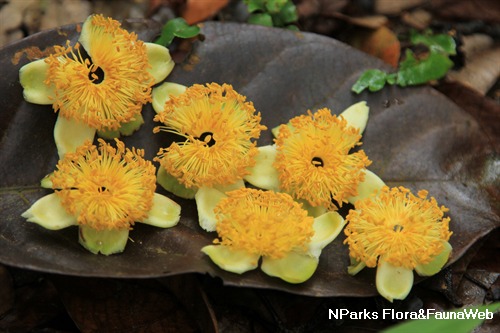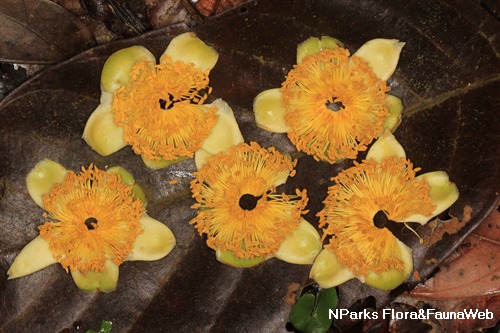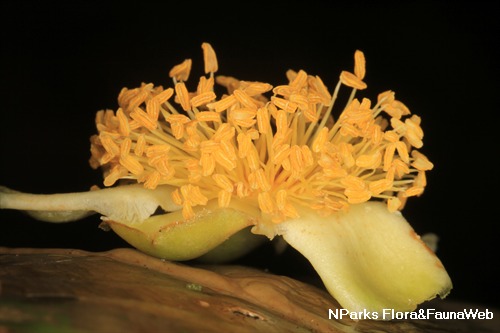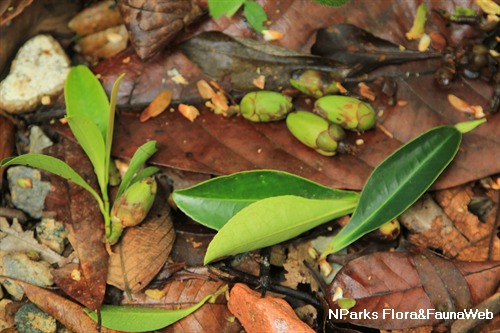
Back
Polyspora singaporeana (Wall. ex Ridl.) Niissalo & L.M.Choo
| Family Name: | Theaceae |
| Synonyms: | Gordonia singaporeana Wall. ex Ridl. |
| Common Name: | Singapore Gordonia |
Name
Classifications and Characteristics
| Plant Division | Angiosperms (Flowering Seed Plants) |
|---|---|
| Plant Growth Form | Tree (Big (>30m)) |
| Lifespan (in Singapore) | Perennial |
| Mode of Nutrition | Autotrophic |
| Plant Shape | Irregular |
| Maximum Height | 31 m |
Biogeography
| Native Distribution | Peninsular Malaysia and Singapore |
|---|---|
| Native Habitat | Terrestrial |
| Preferred Climate Zone | Tropical |
| Local Conservation Status | Native to Singapore (Endangered (EN)) |
Description and Ethnobotany
| Growth Form | It is an evergreen tree up to about 31 m tall, with black, scaly bark. |
|---|---|
| Foliage | Its spirally arranged, stalked leaves have thinly leathery leaf blades that are elliptic or oblong-lance-shaped, 7–15 by 2.5–8 cm, and withering dull red. The leaf blades also have margins that are round-toothed or saw-toothed. |
| Flowers | Its stalked flowers are fleshy, scentless, about 3.8 cm wide, and found singly in the upper leaf axils. The cream-white-petalled flowers open at dusk, with the petals falling off the next morning. |
| Fruit | Its woody fruits are oblong, 3–3.5 cm long, and mature from green to brown. The ripe fruits split from the tip to base into five parts to reveal flat, winged seeds. Its seeds are also 2–2.5 cm long. |
| Habitat | It grows in primary and mature secondary forests, from lowlands up to 1300 m altitude. It occurs locally in Bukit Timah Nature Reserve, Mount Imbiah (Sentosa), in the vicinity of MacRitchie Reservoir, and Pulau Tekong. |
| Etymology | Latin singaporeana, of or from Singapore, referring to one locality in the natural distribution of this species |
| Ethnobotanical Uses | Timber & Products: The timber may be used in light construction such as building boats. |
Landscaping Features
| Landscaping | It is suitable as a park tree for its ornamental flowers. |
|---|---|
| Desirable Plant Features | Ornamental Flowers |
| Landscape Uses | Parks & Gardens |
Fauna, Pollination and Dispersal
| Pollination Method(s) | Biotic (Fauna) |
|---|---|
| Seed or Spore Dispersal | Abiotic |
Plant Care and Propagation
| Light Preference | Full Sun, Semi-Shade |
|---|---|
| Water Preference | Moderate Water |
| Plant Growth Rate | Moderate |
| Rootzone Tolerance | Moist Soils, Well-Drained Soils, Fertile Loamy Soils |
| Maintenance Requirements | Moderate |
| Propagation Method | Seed |
Foliar
| Foliage Retention | Evergreen |
|---|---|
| Mature Foliage Colour(s) | Green |
| Mature Foliage Texture(s) | Leathery, Thin |
| Foliar Type | Simple / Unifoliate |
| Foliar Arrangement Along Stem | Alternate |
| Foliar Attachment to Stem | Petiolate |
| Foliar Shape(s) | Non-Palm Foliage (Lanceolate, Elliptical, Oblong) |
| Foliar Venation | Pinnate / Net |
| Foliar Margin | Serrate / Toothed, Crenulate |
Floral (Angiosperm)
| Flower & Plant Sexuality | Bisexual Flowers |
| Flower Colour(s) | Cream / Off-White, White |
|---|---|
| Flower Grouping | Solitary |
| Flower Location | Axillary |
| Flower Symmetry | Radial |
Fruit, Seed and Spore
| Mature Fruit Colour(s) | Brown |
|---|---|
| Fruit Classification | Simple Fruit |
| Fruit Type | Dehiscent Dry Fruit , Capsule |
| Mature Seed Colour(s) | Brown |
Image Repository
Others
| Master ID | 32321 |
|---|---|
| Species ID | 6729 |
| Flora Disclaimer | The information in this website has been compiled from reliable sources, such as reference works on medicinal plants. It is not a substitute for medical advice or treatment and NParks does not purport to provide any medical advice. Readers should always consult his/her physician before using or consuming a plant for medicinal purposes. |





